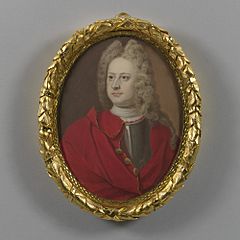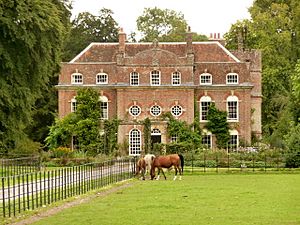John Richmond Webb facts for kids
John Richmond Webb (born 1667, died 1724) was a British general and a politician. He lived at Biddesden House in Wiltshire. He was a member of the House of Commons, which is like a part of today's Parliament, from 1695 to 1724.
Webb was a Tory politician. He supported the Hanoverian Succession, which meant he wanted the Hanover family to become the kings and queens of Britain. This was different from the Jacobite movement, which wanted the old royal family back.
Contents
Early Life and Military Start
John Richmond Webb was the son of Colonel Edmund Richmond Webb. His father was a gentleman from Wiltshire and worked for Prince George of Denmark. John Webb was also a distant cousin of Henry St John, who became a leader of the Tory party.
In 1687, John Webb joined the army as a Cornet, a junior officer in the Dragoons. The next year, he fought in the Glorious Revolution. During a small battle called the Wincanton Skirmish, he was badly hurt by Dutch soldiers.
In 1690, Webb married Henrietta Borlase. She was the daughter of a Member of Parliament. Around 1692 or 1693, he bought Biddesden House in Ludgershall. This property was important because it gave him a lot of power over who was elected to Parliament for that area.
Military and Political Career
Webb became a Member of Parliament (MP) for Ludgershall in 1695. He was a Tory and followed the political ideas of Henry St John. In the same year, he became a Colonel of a foot regiment.
In 1697, he was seriously injured in a duel. The next year, he briefly lost his seat in Parliament. However, he got it back after a special review.
Webb fought in Flanders in 1702–1703. He was a Brigadier at the famous Battle of Blenheim. He also fought as a Major-General at the Ramillies and Oudenarde.
The Battle of Wijnendale
In September 1708, Webb led British troops at the Battle of Wijnendale. He successfully protected a supply convoy from stronger French forces. These supplies were very important for the army besieging Lille. His actions helped the town to be captured later.
However, some people who didn't like the army commander, Marlborough, said that Marlborough gave credit to another officer, William Cadogan, instead of Webb. This was supposedly for political reasons.
Later, Webb received full credit for his bravery and Parliament thanked him. The next year, he was promoted to Lieutenant-General. After this, Webb became a central figure for Tories who were against Marlborough.
Later Career and Retirement
In 1709, Webb fought at the Battle of Malplaquet, where he was badly wounded. He received a large pension and returned to England. He did not serve in active battles again.
In 1710, he became the Governor of the Isle of Wight. This was a military job that also gave him influence over who became MPs for the island's three areas. He used this to become an MP for Newport from 1713 to 1715. This area was often represented by important military figures.
In 1712, he was promoted to General. He was also put in charge of all land forces in Great Britain. However, when George I became king, Webb and other Tories lost their positions.
Webb could not be re-elected in Newport because his old rival, Cadogan, was the new Governor. So, he went back to his family's area, Ludgershall. He represented Ludgershall in Parliament again from 1715 until he died.
Biddesden House
John Richmond Webb replaced the old manor house at Biddesden. He built a large new house using brick and stone around 1711–1712.
Biddesden House has a special round tower with castle-like tops. This tower was built to hold a bell that Webb brought back from Lille after the siege. No one knows for sure who designed the house; it might have been Webb himself. The house is located in a large park and is considered a very important historical building.
Death and Family Legacy
John Richmond Webb passed away on 5 September 1724. He left his estates, which he had made larger by buying more land, to his second son, Borlase Richmond Webb. He did not leave them to his oldest son, Edmund.
His oldest son by his second wife, also named John Richmond Webb, became a lawyer and later a judge and MP.
John Richmond Webb's brother, Thomas Richmond Webb, was an ancestor of the famous writer William Makepeace Thackeray. Thackeray even wrote about John Richmond Webb in his historical novel, The History of Henry Esmond, showing him in a positive way.



